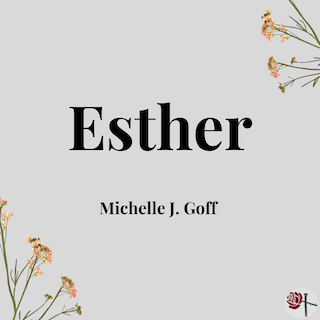 Written by Michelle J. Goff, Director of Iron Rose Sister Ministries
Written by Michelle J. Goff, Director of Iron Rose Sister Ministries
Esther was unaware of the impact that her life would have on the Jewish people, her people. When she answered the call to bravery and potential sacrifice, her uncle spoke these oft-quoted words, “And who knows but that you have come to [this] position for such a time as this?”
When Esther’s words were reported to Mordecai, he sent back this answer: “Do not think that because you are in the king’s house you alone of all the Jews will escape. For if you remain silent at this time, relief and deliverance for the Jews will arise from another place, but you and your father’s family will perish. And who knows but that you have come to your royal position for such a time as this?” (Esther 4:12-14)
A simple Jewish girl, an orphan, was raised by her close relative, Mordecai. Trusting his guidance, she entered the contest for who would become King Xerxes’ new wife. Wisely taking the advice of the king’s servants and the head over all the young virgins, she won the favor of the king and became queen.
However, every good story has a capital villain, a true enemy; it’s the character we love to hate. Within the book of Esther, that villain is Haman. He is selfish, brooding, self-centered, glory-seeking, and cannot stand those who don’t see things his way. Ugh!
As the story unfolds, we discover that Haman has selected the Jews, the chosen people of God, as the recipients of his rage. Mordecai had refused to bow down to him, so now all of the Jews had to pay.
When we already know the end of the story, we may not understand the risk Esther took by approaching the king without being summoned. She, her maidens, Mordecai, and others spend three days fasting and praying before she approaches the king. The tension continues to mount as Haman’s anger grows. In the meantime, God reminds the king of Mordecai’s unrewarded heroism. Will God’s people be saved in time? Why doesn’t Esther just go ahead and tell the king what is happening at the first banquet instead of asking him to another one and waiting another day?
As a child, there are stories that we request again and again. A parent with tired eyes can nearly quote every page as the child also memorizes the narrative, learning many truths through the wonder of reading. One of those important lessons is that we can trust the ending of the story. Fairy tale endings are possible; dreams can come true; dragons will get slain; heroes will arise.
Bible stories are filled with the best heroes and the reminders that God is always in control. We can trust the ending of Histories. I encourage you to read the story of Esther this week. We intentionally selected this story to highlight this week as it coincides with Purim, March 16-17.
Purim is celebrated every year (typically mid-March according to the Western calendar). Children reenact the story, often with costumes or puppets. The festival is a family and community gathering in which the people remember God’s protection from their enemies and provision for their needs (see Esther 8-10).
As with the end of the story of Esther, for those who are on God’s team, it is true that the good guys win and the bad guys lose. In the middle of the story, we may have our doubts, but the book of Revelation reminds us that God is ultimately and definitively victorious.
When the story of Esther is retold as part of Purim, there are certain facets of “audience participation.” The reenactment is intended to be humorous. Therefore, every time Haman enters the story, the children “boo” or “hiss.” Little girls cheer every time Esther’s name is mentioned. Similarly, young men champion Mordecai as the hero of the story. More modern-day narrations may include a tongue-in-cheek reference to Queen Vashti as an early promoter of “women’s lib.” Other colorful characters are interspersed throughout the story, as well.
The story of Esther is rich in its descriptive characters, its narrative form (following the Jewish pattern of storytelling), and its redemptive ending. I have adopted the practice of rereading the Biblical account at least once/year, as inspired by the Purim festival.
Similarly, the Passover story is told once/year at Easter. It is rich in its descriptive characters, its narrative form, and its redemptive ending—in the Exodus account and, of course, as a foreshadowing of Christ as our eternal Redeemer.
I pray that you have been inspired to reread the story of Esther this week, delighting in the reminders of truth or seeds of faith that we and Jewish children have celebrated for centuries. Which part of the story do you love to remember or meditate on? Be sure to share why!